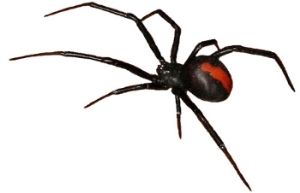The Deadly Fangs of the Redback Spider

While most species of spider are little more than a nuisance, some pack a deadly punch. This reality fosters a common condition known as arachnophobia, or a fear of spiders. The most effective means in combating this phobia is through knowledge and matching proper identities to these arachnid mini-monsters.
Common and Scientific Names
Redback Spider (Latrodectus hasseltii)
Location
Found throughout Australia.
Family
Theridiidae, found throughout the world. Its closest relatives are the North American Black Widow Spider (Latrodectus sp) and the New Zealand Katipo (Latrodectus katipo).
Unique Features
A red stripe runs down the length of its opisthosoma, or abdomen region.
Feeding Habits
It has carnivorous eating habits and is a natural predator to other arthropods as well as insects. The Redback is a nocturnal hunter. Its feeding lifestyle becomes a nuisance to human populations as this spider frequently seeks out remote corners and crevasses during daylight hours.
Natural Predators of the Predator
Non-venomous Harvestmen "Daddy Longlegs" (Hastocularis argus), and the venomous White-Tailed Spider (Lampona cylindrata).
Size
The Redback is about the size of a pea. Females generally get no bigger than 1cm (less than half an inch) and males average 3cm (just over an inch). Human contact is difficult to avoid, given its proclivity to hide in natural and manmade nooks, along with its paltry size.
Behavior
While this arachnid is a predator, it is not naturally inclined towards aggressive behavior outside securing its normal food source. When such an attack occurs, it is because the spider has perceived an imminent threat and is responding in accordance to a means of survival. The highest frequency of bites occurs during the sensitive mating period in the summer months, December through February.
Effective Predatory Features
They have hollow fangs, similar to that of a hypodermic needle. Its venom consists of a powerful neurotoxin called latrotoxin, which swiftly enters the bloodstream of the punctured area.
Side Effects to Humans
Venom quickly attacks the lymphatic and nervous systems. The human lymphatic system affects every organ and every cell in the body. It is the body's primary waste management system to ensure proper circulatory function. Those bitten experience immediate joint pain, nausea, vomiting, and severe stomach cramps. Pain, profuse sweating, and muscle weakness increase over time.
Treatment
Anti-venom is highly successful in combating symptoms. Given the size of this spider, there is a three-hour window between the time of the bite and receiving the anti-venom treatment. Of course, this time structure varies with body types, so medical attention should be sought after straight away. If the bite remains untreated, the result is death. Fortunately, the countermeasure is widely available. There are more than 300 reported bites every year, and since the widespread availability of the antitoxin, there have not been any reported deaths.
This is Deb Duxbury, for Animal Life, reminding you to please spay or neuter your pet.
Common and Scientific Names
Redback Spider (Latrodectus hasseltii)
Location
Found throughout Australia.
Family
Theridiidae, found throughout the world. Its closest relatives are the North American Black Widow Spider (Latrodectus sp) and the New Zealand Katipo (Latrodectus katipo).
Unique Features
A red stripe runs down the length of its opisthosoma, or abdomen region.
Feeding Habits
It has carnivorous eating habits and is a natural predator to other arthropods as well as insects. The Redback is a nocturnal hunter. Its feeding lifestyle becomes a nuisance to human populations as this spider frequently seeks out remote corners and crevasses during daylight hours.
Natural Predators of the Predator
Non-venomous Harvestmen "Daddy Longlegs" (Hastocularis argus), and the venomous White-Tailed Spider (Lampona cylindrata).
Size
The Redback is about the size of a pea. Females generally get no bigger than 1cm (less than half an inch) and males average 3cm (just over an inch). Human contact is difficult to avoid, given its proclivity to hide in natural and manmade nooks, along with its paltry size.
Behavior
While this arachnid is a predator, it is not naturally inclined towards aggressive behavior outside securing its normal food source. When such an attack occurs, it is because the spider has perceived an imminent threat and is responding in accordance to a means of survival. The highest frequency of bites occurs during the sensitive mating period in the summer months, December through February.
Effective Predatory Features
They have hollow fangs, similar to that of a hypodermic needle. Its venom consists of a powerful neurotoxin called latrotoxin, which swiftly enters the bloodstream of the punctured area.
Side Effects to Humans
Venom quickly attacks the lymphatic and nervous systems. The human lymphatic system affects every organ and every cell in the body. It is the body's primary waste management system to ensure proper circulatory function. Those bitten experience immediate joint pain, nausea, vomiting, and severe stomach cramps. Pain, profuse sweating, and muscle weakness increase over time.
Treatment
Anti-venom is highly successful in combating symptoms. Given the size of this spider, there is a three-hour window between the time of the bite and receiving the anti-venom treatment. Of course, this time structure varies with body types, so medical attention should be sought after straight away. If the bite remains untreated, the result is death. Fortunately, the countermeasure is widely available. There are more than 300 reported bites every year, and since the widespread availability of the antitoxin, there have not been any reported deaths.
This is Deb Duxbury, for Animal Life, reminding you to please spay or neuter your pet.
You Should Also Read:
The Evolution of Daddy Longlegs
The Flamboyant Courtship of the Peacock Spider
Are You Scared of Arachnids? Meet the Lifesaver!

Related Articles
Editor's Picks Articles
Top Ten Articles
Previous Features
Site Map
Follow @WildlifeWelfare
Tweet
Content copyright © 2023 by Deb Duxbury. All rights reserved.
This content was written by Deb Duxbury. If you wish to use this content in any manner, you need written permission. Contact Deb Duxbury for details.







